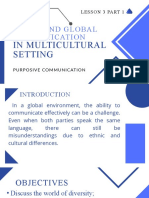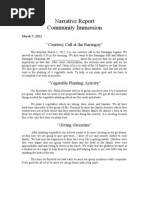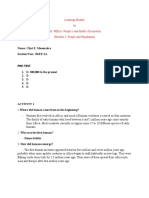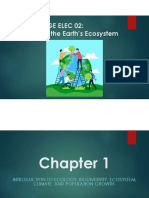Sustainability and Human Values: Lecture Notes 2
Sustainability and Human Values: Lecture Notes 2
Uploaded by
Princess NobleCopyright:
Available Formats
Sustainability and Human Values: Lecture Notes 2
Sustainability and Human Values: Lecture Notes 2
Uploaded by
Princess NobleOriginal Title
Copyright
Available Formats
Share this document
Did you find this document useful?
Is this content inappropriate?
Copyright:
Available Formats
Sustainability and Human Values: Lecture Notes 2
Sustainability and Human Values: Lecture Notes 2
Uploaded by
Princess NobleCopyright:
Available Formats
Republic of the Philippines
CAMARINES SUR POLYTECHNIC COLLEGES
Nabua,Camarines Sur
LECTURE NOTES 2
Sustainability and Human Values
Human Use of the Earth
Environmental sustainability is the responsibility of us humans, to conserve natural resources and protect global
ecosystems to support health and wellbeing, now and in the future. According to Miller, there are three principles
of sustainability: biological diversity (biodiversity), solar energy, and chemical cycling.
Sustainable development is defined as the economic growth that meets the needs of the present without
compromising the ability of future generations to meet their needs. Sustainable development can occur only
within the limits of the environment. Sustainable development encourages us to conserve and enhance our
resource base, by gradually changing the ways in which we develop and use technologies. Countries must be
allowed to meet their basic needs of employment, food, energy, water and sanitation.
Figure 1 Factors of Sustainable Development
Sustainable consumption is defined as the use of goods and services that satisfy basic human needs and improve
the quality of life but that also minimize resource consumption. Some highly developed countries embrace a type
of sustainable consumption called voluntary simplicity, or simple living, is a way of life that rejects the high-
consumption, materialistic lifestyles of consumer cultures and affirms what is often just called 'the simple life' or
'downshifting. Sustainable consumption is also about decoupling economic growth from environmental
degradation, increasing resource efficiency and promoting sustainable lifestyles. Sustainable consumption and
production can also contribute substantially to poverty alleviation and the transition towards low-carbon and
green economies.
Sustainable Development Goals of the United Nations or SDGs are a collection of 17 interlinked global goals
designed to be a "blueprint to achieve a better and more sustainable future for all". The SDGs were set in 2015
by the United Nations General Assembly and are intended to be achieved by the year 2030. They are included in
a UN Resolution called the 2030 Agenda or what is colloquially known as Agenda 2030.
1. No Poverty – End poverty in all its forms everywhere
2. Zero Hunger – End hunger, achieve food security and improved nutrition and promote sustainable
agriculture
3. Good Health and Well-being – Ensure healthy lives and promote well-being for all at all ages
4. Quality Education – Ensure inclusive and equitable quality education and promote lifelong learning
opportunities for all
5. Gender Equality – Achieve gender equality and empower all women and girls
6. Clean Water and Sanitation – Ensure availability and sustainable management of water and sanitation
1
for all
Page
7. Affordable Clean Energy – Ensure access to affordable, reliable, sustainable, and modern energy for all
GE ELECT 2: People and the Earth’s Ecosystem DAVID JOHN B. CANDELARIA
Republic of the Philippines
CAMARINES SUR POLYTECHNIC COLLEGES
Nabua,Camarines Sur
8. Decent Work and Economic Growth – Promote sustained, inclusive and sustainable economic growth,
full and productive employment and decent work for all
9. Industry, Innovation, and Infrastructure – Build resilient infrastructure, promote inclusive and
sustainable industrialization and foster innovation
10. Reducing Inequality – Reduce inequality within and among countries
11. Sustainable Cities and Communities – Make cities and human settlements inclusive, safe, resilient and
sustainable
12. Responsible Consumption and Production – Ensure sustainable consumption and production patterns
13. Climate Action – Take urgent action to combat climate change and its impacts
14. Life Below Water – Conserve and sustainably use the oceans, seas and marine resources for sustainable
development
15. Life On Land – Protect, restore and promote sustainable use of terrestrial ecosystems, sustainably
manage forests, combat desertification, and halt and reverse land degradation and halt biodiversity loss
16. Peace, Justice, and Strong Institutions – Promote peaceful and inclusive societies for sustainable
development, provide access to justice for all and build effective, accountable and inclusive institutions
at all levels
17. Partnerships for the Goals – Strengthen the means of implementation and revitalize the global
partnership for sustainable development
Human Values and Environmental Problems
Environmental ethics is a field of applied ethics that considers the moral basis of environmental responsibility.
Environmental ethics examines moral values to determine how humans should relate to the natural
environment. The main competing paradigms are anthropocentrism, physiocentrism (called ecocentrism as well),
and theocentrism.
Environmental Worldviews a worldview based on how the environment works, our place in the environment,
and right and wrong environmental behaviors. There are two extreme environmental worldviews:
• Western worldview - A worldview based on human superiority over nature, the unrestricted use
of natural resources, and economic growth to manage an expanding industrial base.
• Deep ecology worldview - A worldview based on harmony with nature, a spiritual respect for life,
and the belief that humans and all other species have an equal worth.
Figure 2 Comparison of Environmental Worldviews
Principles of Deep Ecology (Naess et. al., 1989)
1. Both human and nonhuman life have intrinsic value. The value of nonhuman life forms is independent
of the usefulness they may have for narrow human purposes.
2. Richness and diversity of life forms contribute to the flourishing of human and nonhuman life on Earth.
3. Humans have no right to reduce this richness and diversity except to satisfy vital needs
4. Present human interference with the nonhuman world is excessive, and the situation is rapidly
worsening.
2
5. The flourishing of human life and cultures is compatible with a substantial decrease in the human
Page
population. The flourishing of nonhuman life requires such a decrease.
GE ELECT 2: People and the Earth’s Ecosystem DAVID JOHN B. CANDELARIA
Republic of the Philippines
CAMARINES SUR POLYTECHNIC COLLEGES
Nabua,Camarines Sur
6. Improving human well-being requires economic, technological, and ideological changes.
7. The ideological change is mainly that high quality of life need not be synonymous with high levels of
consumption
8. Those who subscribe to the foregoing points have an obligation to participate in the attempt to
implement the necessary changes.
Environmental Justice
Environmental justice is the right of every citizen, regardless of age, race, gender, social class, or other factor, to
adequate protection from environmental hazards. Environmental justice is a fundamental human right in an
ethical society. A growing environmental justice movement has emerged at the grassroots level. Globally,
environmental justice includes promoting economic development without imposing disproportionate
environmental risks.
In the Philippines, environmental justice is a guaranteed state policy affiliated to Section 16, Article II of
the 1987 Constitution which states that “the State shall protect and advance the right of the people to a balanced
and healthy ecology in accordance with the rhythm and harmony of nature.” The seminal landmark case was
Oposa v. Factoran decided in 1993, in which the petitioners were a group of minors, represented by their parents.
The petitioners filed a class suit for themselves, for others of their generation, and for the succeeding generations
to stop deforestation by asserting that specific permits granted by the Government to license holders to cut trees
in the country’s forests violated the right of citizens to a balanced and healthy environment. This was the first
time globally that future generations were recognized as having standing to bring claims, and the first time that
environmental rights of future generations had been considered and upheld by a country’s apex court, and to
this day serves as a milestone in the process of granting access to justice in environmental matters and upholding
environmental rights.
In addition to a number of other legal cases and policy responses in the years that followed, a notable
landmark was the establishment of new Environmental Courts. Through the lead role of the Supreme Court, a
decision was enacted in 2008 designating 117 trial courts as ‘green courts’ with intended special competency
and jurisdiction to oversee cases concerning the environment
An Overall Plan for Sustainable Living
5 Recommendations for Sustainable Living (Brown, 2006)
1. Eliminate poverty and stabilize the human population.
Failing to confront the problem of poverty makes it impossible to attain global sustainability. To
stay within Earth’s carrying capacity, the maximum population that can be sustained indefinitely,
it will be necessary to reach a stable population and reduce excessive consumption.
2. Protect and restore Earth’s resources.
The world’s forests are being cut, burned, and seriously altered for timber and other products
that the global economy requires. Also, rapid population growth and poverty are putting
pressure on forests. Biological diversity, the number and variety of Earth’s organisms, is declining
at an alarming rate. Humans are part of Earth’s web of life and are entirely dependent on that
web for survival.
3. Provide adequate food for all people.
Food insecurity is the condition in which people live with chronic hunger and malnutrition.
Globally, nearly 800 million people lack access to the food needed for healthy, productive lives.
4. Mitigate climate change.
The enhanced greenhouse effect is the additional warming produced by increased levels of gases
that absorb infrared radiation. An increase in atmospheric CO2, mostly produced when fossil
3
Page
fuels are burned and rain forests are destroyed, leads to climate warming. To stabilize climate,
GE ELECT 2: People and the Earth’s Ecosystem DAVID JOHN B. CANDELARIA
Republic of the Philippines
CAMARINES SUR POLYTECHNIC COLLEGES
Nabua,Camarines Sur
we must phase out fossil fuels in favor of renewable energy, increased energy conservation, and
improved energy efficiency, and reduce or reverse deforestation.
5. Design sustainable cities.
The air in cities in the developing world is badly polluted with exhaust from motor vehicles. Illegal
squatter settlements proliferate in cities; the poorest inhabitants build dwellings using whatever
materials they can scavenge. Squatter settlements have the worst water, sewage, and solid
waste problems.
References:
• Berg, Linda R. et. al. (2017) Visualizing Environmental Science
• https://umhelloo.wordpress.com/2015/03/10/biodiversity-solar-power-and-nutrient-cycling-the-three-
principles-of-sustainability/
• https://sphera.com/glossary/what-is-environmental-sustainability/
• https://sdgs.un.org/goals
• http://www.epa.gov/environmentaljustice
4
Page
GE ELECT 2: People and the Earth’s Ecosystem DAVID JOHN B. CANDELARIA
You might also like
- Brief Profile of CajidiocanDocument8 pagesBrief Profile of CajidiocanKATHLENNo ratings yet
- Sustainability and Human Values: Ginno Jhep Acas Pacquing InstructorDocument25 pagesSustainability and Human Values: Ginno Jhep Acas Pacquing InstructorJoshua RogadorNo ratings yet
- Carnival Setting in Aphra Behns The RoveDocument6 pagesCarnival Setting in Aphra Behns The Roveneha rahmanNo ratings yet
- Written Report at Gec 101Document16 pagesWritten Report at Gec 101Chris John CentenoNo ratings yet
- MRR 1 WellsDocument1 pageMRR 1 WellsJoses OlbaNo ratings yet
- Activity 3 RizalDocument21 pagesActivity 3 Rizalellesor macalamNo ratings yet
- Coastal Clean Up 2017Document4 pagesCoastal Clean Up 2017Jenel Apostol AlbinoNo ratings yet
- Chapter 8&9 RIZALDocument7 pagesChapter 8&9 RIZALAllyza MagtibayNo ratings yet
- Description of The LessonDocument6 pagesDescription of The LessonJerald CañeteNo ratings yet
- Tribes of PalawanDocument5 pagesTribes of PalawanJESSA GRACENo ratings yet
- As Stated in The Preamble of Republic Act 1425 or The Rizal LawDocument1 pageAs Stated in The Preamble of Republic Act 1425 or The Rizal LawMuhammad Malik0% (1)
- Carillas, Kier Bonenn G (Activity 2)Document2 pagesCarillas, Kier Bonenn G (Activity 2)Kier Bonenn CarillasNo ratings yet
- Dinagat IslandDocument2 pagesDinagat Islandjed gumapang100% (1)
- Hum 1 COMPLETEDDocument17 pagesHum 1 COMPLETEDRenefrid TejeroNo ratings yet
- REFLECTION/ CRITIQUE (Xavier University) During Our Visition at XU Museum Are I Felt Enjoy Because I See Some Items That NewDocument4 pagesREFLECTION/ CRITIQUE (Xavier University) During Our Visition at XU Museum Are I Felt Enjoy Because I See Some Items That NewDARK SHADOWNo ratings yet
- Profile of SumadelDocument28 pagesProfile of SumadelmpdoNo ratings yet
- Think PaperDocument2 pagesThink PaperJessie FranzNo ratings yet
- The Contemporary World TubioDocument5 pagesThe Contemporary World TubioDexter TubioNo ratings yet
- FS1 Episode 3.1, 3.2Document4 pagesFS1 Episode 3.1, 3.2Levi AckermannNo ratings yet
- LifeDocument2 pagesLifeMichael Don John J. BenipayoNo ratings yet
- Biodiversity and Healthy Society: Lesson ObjectivesDocument11 pagesBiodiversity and Healthy Society: Lesson ObjectivesJamesel VillaruzNo ratings yet
- Environmental ScienceDocument5 pagesEnvironmental ScienceKevin linsonNo ratings yet
- The History and Culture of The Lumad People in MindanaoDocument3 pagesThe History and Culture of The Lumad People in MindanaoKelsey RojasNo ratings yet
- Name: Marvin Batasinin BSRT-1C Deadline of Submission: April 21, 2020 Instructor: Ms. Jenessa C. Atibagos RatingDocument3 pagesName: Marvin Batasinin BSRT-1C Deadline of Submission: April 21, 2020 Instructor: Ms. Jenessa C. Atibagos RatingNikko AtabeloNo ratings yet
- Ethics Activity Unit 2Document8 pagesEthics Activity Unit 2Rodriguez Vea Janelle DC.No ratings yet
- History of ManoboDocument2 pagesHistory of ManoboTroy Kent MitchelleNo ratings yet
- Period of Enlightenment (1872-1898)Document8 pagesPeriod of Enlightenment (1872-1898)Marvin GeneblazoNo ratings yet
- Darwin Bio DataDocument3 pagesDarwin Bio DataRoche DaleNo ratings yet
- Module 3 PDFDocument11 pagesModule 3 PDFVincee SamsonNo ratings yet
- Course Title Course Code Pre-requisite/Co-requisiteDocument9 pagesCourse Title Course Code Pre-requisite/Co-requisiteRuthchell CiriacoNo ratings yet
- Bontoc (Igorots) Dumagat: GEE 006 Philippine Indigenous Communities Week 4 Mrs. Gina S. GiliDocument2 pagesBontoc (Igorots) Dumagat: GEE 006 Philippine Indigenous Communities Week 4 Mrs. Gina S. GiliGilyn NaputoNo ratings yet
- Newton Q&ADocument3 pagesNewton Q&AJamesFooNo ratings yet
- World of DiversityDocument35 pagesWorld of DiversityRyan BuerNo ratings yet
- Narrative Report (SF2)Document2 pagesNarrative Report (SF2)Shane De Pedro Bareñan100% (1)
- Tinggian Similarities and DifferencesDocument2 pagesTinggian Similarities and DifferencesLoren MandaNo ratings yet
- The First Philippine RepublicDocument21 pagesThe First Philippine RepublicMa Luisa InsonNo ratings yet
- Chapter 2 Natural Setting and PeopleDocument34 pagesChapter 2 Natural Setting and PeopleMarc J.A. Lebrillo100% (2)
- Tinikling Philippine National Folk DanceDocument3 pagesTinikling Philippine National Folk DanceAllyson VillarealNo ratings yet
- Industrial Wastes of Libmanan River and Its Effects To The Quality of The River and Its Life FormsDocument25 pagesIndustrial Wastes of Libmanan River and Its Effects To The Quality of The River and Its Life FormsAlaii CuyaNo ratings yet
- MOLINA Lesson 4 Post Assessment PHYS 216ADocument4 pagesMOLINA Lesson 4 Post Assessment PHYS 216AZylle Pearl Castillo JerezNo ratings yet
- Module 1 in EthicsDocument35 pagesModule 1 in EthicsJude cañeteNo ratings yet
- Rattan and Vine Craft Act.Document4 pagesRattan and Vine Craft Act.Glen Mark Bautista100% (1)
- Metacognitive Reading Report 11Document1 pageMetacognitive Reading Report 11SHELPTSNo ratings yet
- Ecological DimensionDocument6 pagesEcological DimensionMurien LimNo ratings yet
- GRADES 1 To 12 Daily Lesson Log Monday Tuesday Wednesday Thursday FridayDocument3 pagesGRADES 1 To 12 Daily Lesson Log Monday Tuesday Wednesday Thursday FridayCristine Sabellano100% (3)
- URSOLINO - JAY - LESTER - D. - BEED - 1 - GEED 10063 - Purposive Communication - ASSESSMENT-IN - LESSON-2Document4 pagesURSOLINO - JAY - LESTER - D. - BEED - 1 - GEED 10063 - Purposive Communication - ASSESSMENT-IN - LESSON-2Jay Lester UrsolinoNo ratings yet
- To The Filipino YouthDocument3 pagesTo The Filipino YouthPaula QuizanaNo ratings yet
- Regions of The PhilippinesDocument7 pagesRegions of The PhilippinesRebecca CaponongNo ratings yet
- Philippine Folk Dances - HistoryDocument5 pagesPhilippine Folk Dances - HistoryRasalyn Cericos Valois0% (1)
- Agrarian Uprising 1745Document3 pagesAgrarian Uprising 1745Jow Biden SilvaNo ratings yet
- Fruit and Tree Crop Production and Management: Prelim Notes in Epp 2Document16 pagesFruit and Tree Crop Production and Management: Prelim Notes in Epp 2JizabelNo ratings yet
- Purok 6, Bulanao, Tabuk City, Kalinga 3800Document21 pagesPurok 6, Bulanao, Tabuk City, Kalinga 3800Jess ArceoNo ratings yet
- PEECO-FINAL Clint E. MosenabreDocument36 pagesPEECO-FINAL Clint E. MosenabreJea MosenabreNo ratings yet
- Afa 1 Module 5 ActivitiesDocument6 pagesAfa 1 Module 5 ActivitiesJulius Balbin100% (2)
- Carl Vincent B. Autida BSIT 2A ActivityDocument3 pagesCarl Vincent B. Autida BSIT 2A Activityshadow gonzalezNo ratings yet
- This Study Resource Was: Assessment Task 6-1Document2 pagesThis Study Resource Was: Assessment Task 6-1JaysonNo ratings yet
- Worksheet For Weeks 2 To 4 Buron Ma. Janezel MDocument4 pagesWorksheet For Weeks 2 To 4 Buron Ma. Janezel Mangelo aquinoNo ratings yet
- PWDFinal Copy 1Document23 pagesPWDFinal Copy 1Rodney CaingletNo ratings yet
- Financial Capital / Liquidity TheoryDocument8 pagesFinancial Capital / Liquidity TheoryMaria Angelica Mae BalmedinaNo ratings yet
- Norhaina by Don PagusaraDocument8 pagesNorhaina by Don PagusaraAllen EnanoriaNo ratings yet
- GE ELEC 02 LectureDocument28 pagesGE ELEC 02 LectureChristine Joy BaluconNo ratings yet
- MODULE+17 in English Ma. Charisse Bruca Gr. 9 St. ElizabethDocument3 pagesMODULE+17 in English Ma. Charisse Bruca Gr. 9 St. ElizabethPrincess NobleNo ratings yet
- Ma. Charisse Module 16 in English gr.9 St. ElizabethDocument3 pagesMa. Charisse Module 16 in English gr.9 St. ElizabethPrincess NobleNo ratings yet
- Noble, Princess C. Bsme-4b My Creative PersonaDocument4 pagesNoble, Princess C. Bsme-4b My Creative PersonaPrincess NobleNo ratings yet
- Noble, Princess C. Bsme-4bDocument1 pageNoble, Princess C. Bsme-4bPrincess NobleNo ratings yet
- Title Defense - SAMPLEDocument40 pagesTitle Defense - SAMPLEPrincess NobleNo ratings yet
- Drill Lesson On Zero Intergral Exponent Ma. Charisse Bruca 9 St. ElizabethDocument1 pageDrill Lesson On Zero Intergral Exponent Ma. Charisse Bruca 9 St. ElizabethPrincess NobleNo ratings yet
- Computer Module 1 - Ma. Charisse P. Bruca 9 - St. ElizabethDocument2 pagesComputer Module 1 - Ma. Charisse P. Bruca 9 - St. ElizabethPrincess NobleNo ratings yet
- Week 2 MODULE 1Document3 pagesWeek 2 MODULE 1Princess NobleNo ratings yet
- ACTIVITY 1 in Science - Ma. Charisse Bruca 9 St. ElizabethDocument1 pageACTIVITY 1 in Science - Ma. Charisse Bruca 9 St. ElizabethPrincess NobleNo ratings yet
- Refrigeration System Setup: Refrigeration and Hvac Labvolt Series User GuideDocument72 pagesRefrigeration System Setup: Refrigeration and Hvac Labvolt Series User GuidePrincess NobleNo ratings yet
- TASK No. 2 - PERFORMING SPLIT TYPE AIRCON WIRING SYSTEMDocument2 pagesTASK No. 2 - PERFORMING SPLIT TYPE AIRCON WIRING SYSTEMPrincess NobleNo ratings yet
- Porter's Diamond, AAA, & CAGEDocument10 pagesPorter's Diamond, AAA, & CAGEIrish June TayagNo ratings yet
- News Linguistic Features PDFDocument24 pagesNews Linguistic Features PDFKenali MaliNo ratings yet
- Consumer Durable IndustryDocument20 pagesConsumer Durable Industryvipul tutejaNo ratings yet
- No Homework in Other CountriesDocument4 pagesNo Homework in Other Countriesafnoescijgwdgw100% (1)
- Supplier Quality Manual: Release Date: August 2017Document23 pagesSupplier Quality Manual: Release Date: August 2017DIRK HARDINGNo ratings yet
- BanksDocument37 pagesBanksMuhammad Asif KhanNo ratings yet
- TechnoStruct - Company ProfileDocument18 pagesTechnoStruct - Company ProfileShashank SharmaNo ratings yet
- Strategic Intervention Plan in CATCH UP FRIDAY READINGDocument3 pagesStrategic Intervention Plan in CATCH UP FRIDAY READINGJENNEFER PASCUANo ratings yet
- The University of Birmingham Data Protection Policy A.: Appendix 1Document17 pagesThe University of Birmingham Data Protection Policy A.: Appendix 1Muhammad Akbar WalennaNo ratings yet
- 12 Years A SlaveDocument55 pages12 Years A Slavezzrot1No ratings yet
- Give Reasons of Class X ClimateDocument8 pagesGive Reasons of Class X ClimatethakurbobbieNo ratings yet
- Budgeting MC QuestionsDocument3 pagesBudgeting MC QuestionsCecile S CameronNo ratings yet
- Pain ModuleDocument21 pagesPain ModuleBlake Kammin100% (1)
- Cambria County Prison: Visitation GuidelinesDocument1 pageCambria County Prison: Visitation GuidelinesShelley KauffmanNo ratings yet
- Project Quality Plan With All Forms & Checklists - Method Statement HQDocument4 pagesProject Quality Plan With All Forms & Checklists - Method Statement HQsvsrnbNo ratings yet
- Ejemplos:: Campos-Martinez PDFDocument2 pagesEjemplos:: Campos-Martinez PDFxiomara sanchezNo ratings yet
- Bless Me, Ultima: Chapter Guided Reading Questions DirectionsDocument4 pagesBless Me, Ultima: Chapter Guided Reading Questions Directionsapi-357511349No ratings yet
- Vajrasūcika Upaniṣad - Sanskrit and EnglishDocument4 pagesVajrasūcika Upaniṣad - Sanskrit and EnglishShashank Vkg RaoNo ratings yet
- Non-Disclosure AgreementDocument3 pagesNon-Disclosure AgreementLorinel MendozaNo ratings yet
- Maquiling v. Comelec, G.R. No. 195649, April 16, 2013Document47 pagesMaquiling v. Comelec, G.R. No. 195649, April 16, 2013DodongNo ratings yet
- AA015 UPS 1 - TEST - Google FormsDocument5 pagesAA015 UPS 1 - TEST - Google Formsami zawaniNo ratings yet
- 1 Essential Contract Elements PetDocument22 pages1 Essential Contract Elements Petahmed100% (1)
- Loyola Grand Villa Homeowners South Association Vs CADocument1 pageLoyola Grand Villa Homeowners South Association Vs CACharlotteNo ratings yet
- Philippine Teachers Professionalization Act of 1994Document15 pagesPhilippine Teachers Professionalization Act of 1994Jesselle Hannah Agbayani Ancheta-RuizNo ratings yet
- Roll Number: BR26000514 Application Number: 223510009172: Test DetailsDocument3 pagesRoll Number: BR26000514 Application Number: 223510009172: Test DetailsAbhinav Kumar SinghNo ratings yet
- Financial FeasibilityDocument2 pagesFinancial Feasibilityaryanboxer786No ratings yet
- FypDocument10 pagesFypindramanigagaraiNo ratings yet
- Powers of RegistrarDocument2 pagesPowers of RegistrarsahilNo ratings yet
- INDU1106 - Module Handbook - 202324Document19 pagesINDU1106 - Module Handbook - 202324Bop Bi BauNo ratings yet




































































































